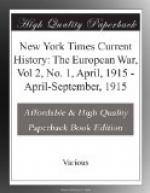Supported by land naval artillery the Indian troops took the offensive. The Serapeum garrison, which had stopped the enemy three-quarters of a mile from the position, cleared its front, and the Tussum garrison by a brilliant counter-attack drove the enemy back. Two battalions of Anatolians of the Twenty-eighth Regiment were thrown vainly into the fight. Our artillery gave them no chance, and by 3:30 in the afternoon a third of the enemy, with the exception of a force that lay hid in bushy hollows on the east bank between the two posts, were in full retreat, leaving many dead, a large proportion of whom had been killed by shrapnel.
Meanwhile the warships on the lake had been in action. A salvo from a battleship woke up Ismailia early, and crowds of soldiers and some civilians climbed every available sandhill to see what was doing till the Turkish guns sent shells sufficiently near to convince them that it was safer to watch from cover. A husband and wife took a carriage and drove along the lake front, much peppered by shells, till near the old French hospital, when they realized the danger and suddenly whisked around and drove back full gallop to Ismailia.
But the enemy’s fire did more than startle. At about 11 in the morning two six-inch shells hit the Hardinge near the southern entrance of the lake. The first damaged the funnel and the second burst inboard. Pilot Carew, a gallant old merchant seaman, refused to go below when the firing opened and lost a leg. Nine others were wounded. One or two merchantmen were hit, but no lives were lost. A British gunboat was struck.
Then came a dramatic duel between the Turkish big gun or guns and a warship. The Turks fired just over and then just short of 9,000 yards. The warship sent in a salvo of more six-inch shells than had been fired that day.
During the morning the enemy moved toward Ismailia Ferry. The infantry used the ground well, digging shelter pits as they advanced, and were covered by a well-served battery. An officer, apparently a German, exposed himself with the greatest daring, and watchers were interested to see a yellow “pie dog,” which also escaped, running about the advancing line. Our artillery shot admirably and kept the enemy from coming within 1,000 yards of the Indian outposts. In the afternoon the demonstration—for it was no more—ceased but for a few shells fired as “a nightcap.” During the dark night that followed some of the enemy approached the outpost line of the ferry position with a dog, but nothing happened, and day found them gone.
At the same time as the fighting ceased at the ferry it died down at El Kantara. There the Turks, after a plucky night attack, came to grief on our wire entanglements. Another attempt to advance from the southeast was forced back by an advance of the Indian troops. The attack, during which it was necessary to advance on a narrow front over ground often marshy with recent inundations against our strong position, never had a chance. Indeed, the enemy was only engaged with our outpost line.




